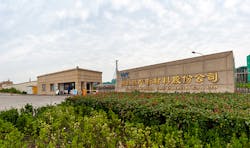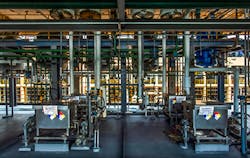Continuous Flow Reactors Yield Multiple Benefits
By Yi Jiang Corning Advanced-Flow Reactor Technology Co., Ltd.
Chemical production is entering a new era. Breakthrough innovations in inherently safer flow chemistry technology now offer chemical and pharmaceutical manufacturers attractive alternatives that potentially can provide dramatic improvements in environmental impact and operating efficiency. Three pioneers in this field — Zhejiang Weihua New Material Co. (Weihua), Shangyu, China; Shanghai Hybrid-Chem Technology Co. (Hybrid-Chem), Shanghai; and Corning Advanced-Flow Reactor Technology Co., Ltd. (Corning AFR), Changzhou, China — collaborated to demonstrate what could become a sea change in the way chemicals are mass produced in the future.
These developments in continuous flow manufacturing have come at an opportune time. Environmental and safety regulations for chemical and pharmaceutical manufacturing are becoming more stringent. In addition, the world’s demand for the industries’ products shows no signs of slowing down.
The Problem
The hazards associated with chemical production are a widespread concern around the world — perhaps nowhere more than in China, the world’s largest producer and consumer of chemicals. In recent years, explosions at chemical plants in China have killed hundreds of people. For instance, a March 2019 blast in Jiangsu Province resulted in 78 deaths and more than 600 injuries.
Traditionally, most fine chemical plants have used batch processing to make products that meet unique end-user requirements. This approach often is suited for small-scale production due to its flexibility. However, as demand has grown for chemicals in almost every facet of modern life — from plastic packaging to fertilizer and food — manufacturing plants have scaled up production. This requires larger batches, along with greater heat exchange and mixing demands, and has led to higher volatility and risk. Many industry experts also were concerned that conventional batch processing scale-ups often led to greater environmental hazards and an increased potential for explosions.
Continuous flow manufacturing provides an inherently safer technology that reduces the volumetric holdup of reactants in the production line and allows for higher precision in process variable controls. Thus, such production, especially via microchannels of unique designs, typically offers high potential for improved handling of hazardous reactions compared to batch processing. Flow reactor process systems — in which dosing pumps and tubes move reactant fluids in a tightly controlled, continuously flowing stream rather than a large batch — are ideal for manufacturing key starting materials, active pharmaceutical ingredients as well as various fine chemicals and their intermediates. Over the last decade, some fine chemicals and pharmaceutical manufacturers have increased their use of the flow method. Until recent years, though, microchannel flow reactor technology has not offered the volume throughput per reactor that is needed by large plants for efficient full-scale manufacturing with an attractive return on investment (ROI). In addition, use of numerous small-volume-throughput microchannel reactors (so-called “numbering up”) resulted in complicated flow management, high capital investment and potential challenges in operations and plant maintenance.
Three-Way Collaboration
Weihua decided to face this challenge head-on. Beginning in 2019, Weihua worked with Hybrid-Chem and Corning AFR, one of the world’s leading innovators in flow reactor technologies, with one goal in mind: to create more-efficient and continuous chemical production systems built around inherently safer technology that also can reduce environmental impact.
Weihua and Hybrid-Chem both had relationships with Corning AFR going back more than a decade.
Qiangbiao Pan, general manager of Weihua, became familiar with Corning’s flow reactor technology during his time at Lianhe Chemical Technology Co., Ltd., Taizhou, China, one of the earliest customers to invest in Corning AFR’s G1 multipurpose process-development platform.
After moving to Weihua in 2018 as general manager, Pan decided to explore industrial production with the AFR technology. Weihua — like many other chemical manufacturers in China — was using conventional batch reactor processes to produce a variety of chemical intermediates for agricultural chemicals and pharmaceutical products. Meanwhile, Corning had greatly expanded its unit reactor throughput capacity with the 2014 launch of the G4 reactor, which can process 2,000 mt/y, a level suitable for commercial-scale manufacture of many products.
Believing in the potential of flow technology and Corning’s expertise to continually improve unit-reactor annual throughput capacity, Pan reached out to Ma at Hybrid-Chem in late 2018. He suggested a three-way collaboration with Corning AFR to transition Weihua’s agrochemical batch production lines into a fully integrated continuous-flow process. Key to their success would be Corning’s G5 reactor — which at that time had not yet been released to the industry in general but enabled throughput of 10,000 mt/y per reactor and, thus, offered a favorable way to maximize Weihua’s ROI.
The Solution
Such complex plans would typically take several years to come to fruition. However, after just one year of close collaboration, Weihua, Hybrid-Chem and Corning AFR completed their plant project; Weihua started transitioning its conventional batch process into a new integrated AFR G5 system in November 2019.
Hybrid-Chem’s technology teams developed the process on Corning’s G1 reactor. Next, they seamlessly scaled up to industrial production on G5 reactors at Weihua with strong support from Corning AFR engineering, significantly mitigating delivery and investment risks for the project. Efforts went so well that after 100 days of successfully running a 10,000-mt/y production line, Weihua doubled its AFR production with a second 10,000-mt/y line.
The system was able to withstand the strong corrosive environment and operate successfully for 8,000+ hours per year without disruption due to Corning’s durable silicon-carbide plates that integrate a metal frame with fully automatic controlled auxiliaries for efficient fluidic flow and thermal management,
The flow-reactor process at Weihua involves a two-step synthesis. First, diazotization takes place in Corning’s G5 reactor. After this comes hydrolysis, using one G5 reactor followed by one tube reactor to satisfy residence time requirements.
Significant Benefits
Weihua has now been operating two continuous AFR production lines in parallel using Corning’s G5 reactors for more than two years. Over this time, the company has achieved positive results in safety, environmental impact and efficiency. Moreover, Weihua has received recognition from provincial and national governments as well as national industrial associations for inherently safer and advanced technology adoption.
Important benefits achieved include:
• inherently safer technology, with substantial reduction in reactor holdup volume (reactor chemical holdup dropped by 99.9% for diazotization and 96.5% for hydrolysis);
• improved process efficiency (instead of eight hours of reaction time per batch, the new system requires just several seconds of residence time for diazotization; for the hydrolysis step, instead of taking four hours, the process needs only several seconds in the G5 and several minutes in the tube reactors);
• continuously stable production for 8,000+ h/y;
• solid waste reduction of 75%; and
• significantly increased yield and improved profits.
The new system also occupies a dramatically smaller manufacturing footprint than the previous batch system. In the first step, one Corning G5 reactor replaced six batch reactors of 3,000-L each. In the second step, one G5 and one tube reactor supplanted three batch reactors of 6,000-L each. Overall, the AFR system takes up only about one-tenth the area of the original batch process and requires 30 fewer operators — with a corresponding decrease in capital expenditure and operating costs. The payback period for the project’s investment was less than 20 months.
It’s also important to note that Corning’s AFR technology addressed a critical challenge faced in the Weihua batch process system: the presence of a certain amount of hydrofluoric acid caused severe equipment corrosion in production lines. Corning’s AFR technology and robust flow system enabled excellent corrosion resistance using specialty silicon-carbide fluidic modules for reactors and metal-free dosing lines, which resulted in much less time and cost for system maintenance.
The project has evoked positive feedback from those involved.
“The belief and the trust of collaborators are essential to the success of the project. We are confident about this flow direction, and about Corning AFR technology,” emphasizes Dr. Ma.
“Compared with traditional batch processing, Corning’s continuous flow technology is convenient to start and stop, saves time in loading and unloading, and also reduces potential damages caused by human error,” adds Dr. Pan. “Less chemicals are in the reaction process with precise DCS [distributed control system] control, and the process is reliable and inherently safer. The two-step consecutive reaction along with downstream separation steps are carried out continuously, which greatly improves the total process and overall production efficiency.”
An Attractive Alternative
Based on the success of the collaboration with Weihua and Hybrid-Chem, Corning AFR has continued to implement its flow reactor technology in large-scale chemical production facilities. Over the past two and a half years, the AFR team has installed more than 60 G5 industrial units in China alone.
Corning AFR is also assisting the chemical and pharmaceutical industries to shift to an inherently safer continuous process design, implement a more environmentally conscious system, and respond more actively to changing market requirements. At the same time, AFR technology helps customers increase profits and achieve sustainable development.
AFR technology has become an important driver enabling chemical and pharmaceutical companies to transform from conventional to modern manufacturing methods, with enormous benefits including help in meeting global sustainability and carbon neutrality objectives.
YI JIANG is chairman and general manager of Corning Advanced-Flow Reactor Technology Co., Ltd., Changzhou. Email him at [email protected].
ACKNOWLEDGEMENT
The author gratefully thanks Dr. Bing Ma, general manager of Shanghai Hybrid-Chem Technology Co., Ltd., and Dr. Qiangbiao Pan, general manager of Zhejiang Weihua New Material Co., Ltd., for their strong support in implementing large-scale AFR reactor technology as well as for their contributions to this article.

